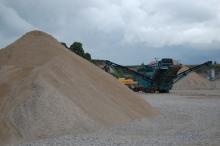A review of the Environmental Impact Assessment Directive and its implications for the Aggregates Industry
Environmental assessment is a procedure that ensures the environmental implications of decisions are taken into account before the decisions are made.
Environmental assessment can be undertaken for individual projects.
On 26 October, the
The proposal for a new Directive is the result of a review process started in 2009 when the European Commission published a report on the application and effectiveness of the EIA Directive.
A public consultation then took place in 2010, which was concluded with a conference to celebrate the 25th anniversary of the Directive. The results of the consultation and of the discussions during the conference fed into the review process.
The objectives of the review are to:
- Take into account the changes in the policy, legal and technical context in the past 25 years.
- Correct three identified shortcomings: the screening procedure; the quality and analysis of the EIA, and the risk of inconsistencies with other legislations.
- Simplify the EIA process.
The review is consistent with the Roadmap towards a Resource Efficient Europe and should therefore address this by introducing new requirements related to limited resources (for example, biodiversity).
The implications for the Aggregates Industry are summed up below.
Screening procedure
Specification of the content and justification of screening decisions by Member States. Modification of Annex III to describe the selection criteria. In particular hydromorphological changes; impacts of the project on climate change (in terms of greenhouse gas emissions); impacts of the project on land, soil, water, air and biodiversity; impacts on landscape, and cumulation of impacts with existing or approved projects.
Quality and analysis of the EIA
- Reinforce the quality of the process (that is mandatory scoping and quality control of EIA information).
- Specify the content of the EIA report with a detailed list of information to be provided (see new Annex II.A and modified Annex IV).
This includes description of sub-surface and water use; energy and natural resources used (including water, land, biodiversity and soil); mandatory assessment of reasonable alternatives, and a description of the likely evolution of the area without the implementation of the project.
- EU Member States are obliged to justify their decision on EIAs which might be challenged.
Risk of inconsistencies and overlapping with other legislation
- Specification of time frames for the main stages required by the Directive: public consultation (30-60 days); screening decision (three months); final EIA decision (three months after all necessary information gathered).
- Introduce a mechanism (a kind of EIA one-stop shop) to avoid duplication and overlapping with other legal requirements originating from EU legislation such as Directive 2010/75/EU (integrated pollution prevention and control); 92/43/EEC (Habitats Directive), and 2001/42/EC (Strategic Environmental Assessment).
The assessment of alternatives, monitoring and the adaptation of the EIA to new challenges on biodiversity, climate change, disaster risks, availability of natural resources might result in higher costs for companies.
Next steps
The proposal will be considered by the European Parliament and the Council (ordinary legislative procedure; former co-decision), most likely in 2013. It is expected that the approved text should enter into force in March 2014.
For further information, you can contact the
the association’s website: %$Linker:







